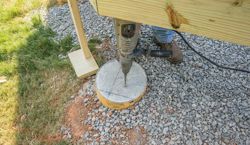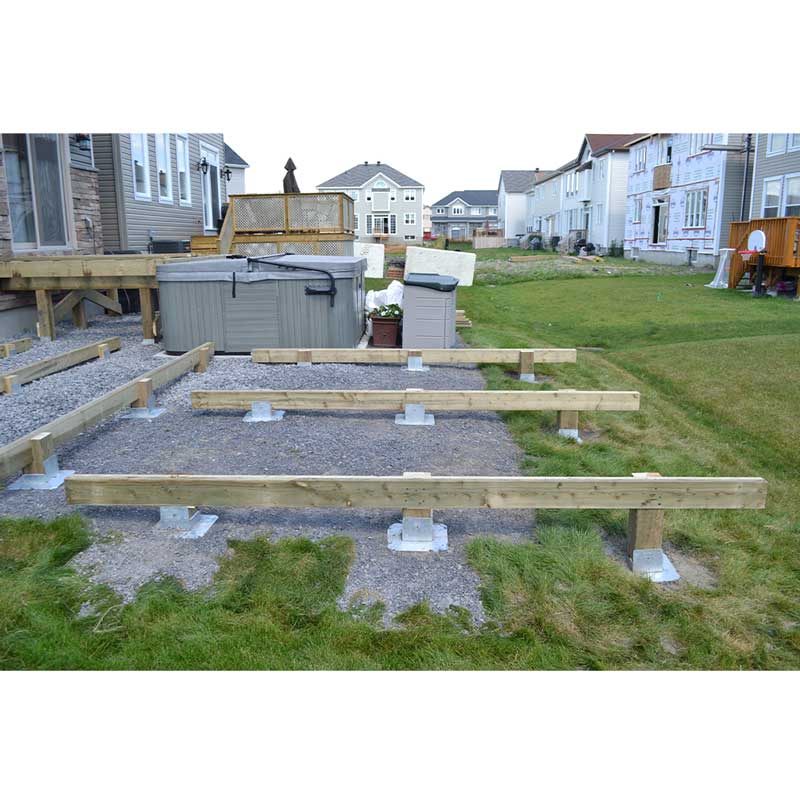Professional Tips for Installing Deck Footings to Assistance Your Outdoor Space
When it involves constructing a deck, one of one of the most essential components to take into consideration is the installment of appropriate footings. These footings are the structure upon which your outdoor area will certainly rest, giving security and support for many years ahead. What specifically does it take to set up deck footings properly? In this conversation, we will certainly check out experienced suggestions and strategies that can aid guarantee a sturdy and effective deck installation. From choosing the appropriate kind of footings to avoiding common errors, we will certainly give you with the knowledge and insights you require to with confidence start your deck-building trip. So, allow's dive right in and uncover the key to a resilient and strong outside room.
Value of Appropriate Deck Grounds
Proper deck grounds are essential for making certain the stability and longevity of your outside area. Without solid and appropriately installed grounds, your deck might come to be unstable, leading to safety and security risks and pricey repairs.

In enhancement to stability, correct deck grounds also add to the longevity of your outdoor room (Deck Footings). Grounds that are developed and constructed to stand up to the aspects and soil problems in your location will help avoid the deck from shifting or clearing up over time. By guaranteeing the grounds are appropriately sized and installed, you can decrease the threat of damages to the deck structure, expanding its life expectancy and reducing the need for pricey repair services or replacements

Selecting the Right Kind of Grounds
When picking the ideal kind of grounds for your deck, it is essential to consider factors such as soil conditions, neighborhood building ordinance, and the total layout of your exterior room. The type of footing you pick will certainly play a crucial duty in making certain the stability and durability of your deck.
One usual kind of footing is the concrete ground. Concrete footings appropriate for the majority of soil problems and provide excellent support for decks. They are usually installed below the frost line to stop moving and resolving as a result of freezing and thawing cycles. Another option is helical piers, which are optimal for locations with unpredictable soil or high water tables. These piers are screwed into the ground and provide strong support for the deck.
Sometimes, you may need to use specialized footings, such as heap grounds or deep foundations, if you are building a multi-level or huge deck. These grounds are created to disperse the weight of the deck over a bigger area, making sure security and stopping clearing up or sinking.
Before choosing a type of ground, it is necessary to speak with local building regulations and laws to make sure conformity. In addition, think about the design and planned use your outdoor space. Elements such as the dimension, shape, and load-bearing demands of your deck will certainly affect the sort of footing that is most appropriate.
Preparing the Ground for Footing Installation
To effectively prepare the ground for footing installment, it is essential to assess the dirt conditions and take required steps to make certain security and resilience of the deck. The primary step is to dig deep into the area where the grounds will be mounted. The depth of the excavation will depend upon the frost line in your region and the certain requirements of the deck layout. It is vital to eliminate any plants, rocks, or debris from the excavation to make certain a solid structure.
As soon as the area has been dug deep into, the following action is to portable the dirt. This can be done utilizing a plate compactor or by using a hand meddle. Compacting the soil aids to remove any type of gaps or air pockets, which can lead to clearing up and instability resource with time.
After compacting the soil, it is necessary to lay a layer of gravel or smashed rock at the end of the excavation. This will give drain and assistance to stop water from pooling around the footings, which can lead to disintegration and instability.
Step-by-Step Guide to Putting Up Deck Footings
After effectively preparing the ground for footing installment, the next step is to begin the procedure of mounting deck grounds. This step-by-step guide will give you with a clear understanding of how to install deck grounds for your outdoor space.
Figure out the location: Begin by marking the positions of the deck grounds using risks and string. Make sure that the areas align with the layout and format of your deck.
Dig the holes: Make use of a message opening digger or an auger to dig the holes for the grounds. The depth and size of the openings need to remain in conformity with local structure codes and the details needs of your deck style.
Degree the openings: Utilize a degree to make sure that the openings are dug to the correct deepness and are degree with each other. (Deck Footings)
Add crushed rock: Area a layer of crushed rock at the base of each hole to improve drain and protect against the wood from decomposing.
Place the footings: Place the footings right into the holes, seeing to it they are level and plumb. Utilize a degree and a gauging tape to guarantee precision.
Secure the grounds: Pour concrete right into the holes around the grounds, loading them to the top. Use a blog post level to make certain the grounds remain degree as the concrete collections.
Enable time for curing: Let the concrete remedy according to the supplier's guidelines prior to waging the deck building.
Common Mistakes to Stay Clear Of During Footing Installment
One crucial aspect to consider during the installation of deck grounds is avoiding usual mistakes that can endanger the security and long life of your exterior space. While deck grounds might look like a straightforward and uncomplicated component of the construction process, ignoring certain factors can result in pricey fixings and potential safety threats down the line.

Additionally, ignoring to set up proper drain actions can trigger water to gather around the grounds, bring about rot, degeneration, and the ultimate weakening of the deck's foundation. Making use of the wrong type of footing product or stopping working to properly safeguard the grounds can endanger their architectural integrity.
To avoid these mistakes, it is crucial to talk to a professional or follow industry standards to guarantee correct footing installation. By doing so, you can guarantee the security and long life of your exterior space, offering a safe and enjoyable atmosphere for years to come.
Conclusion
In verdict, setting up proper deck grounds is vital for the security and long life of your exterior area. By choosing the appropriate kind of their website grounds and effectively preparing the ground, you can guarantee a solid structure for your deck. Complying with a detailed overview and preventing usual mistakes throughout footing installation will certainly better boost the longevity and security of your deck.
Correct deck footings are vital for making sure the security and longevity of your exterior area. The grounds serve as a link in between the ground and the deck, permitting the weight of the deck and its occupants to be distributed uniformly right into the dirt.One typical type of ground is the concrete ground. Insert the footings: here Place the footings right into the openings, making sure they are level and plumb. Safeguard the footings: Put concrete into the openings around the grounds, loading them to the top.